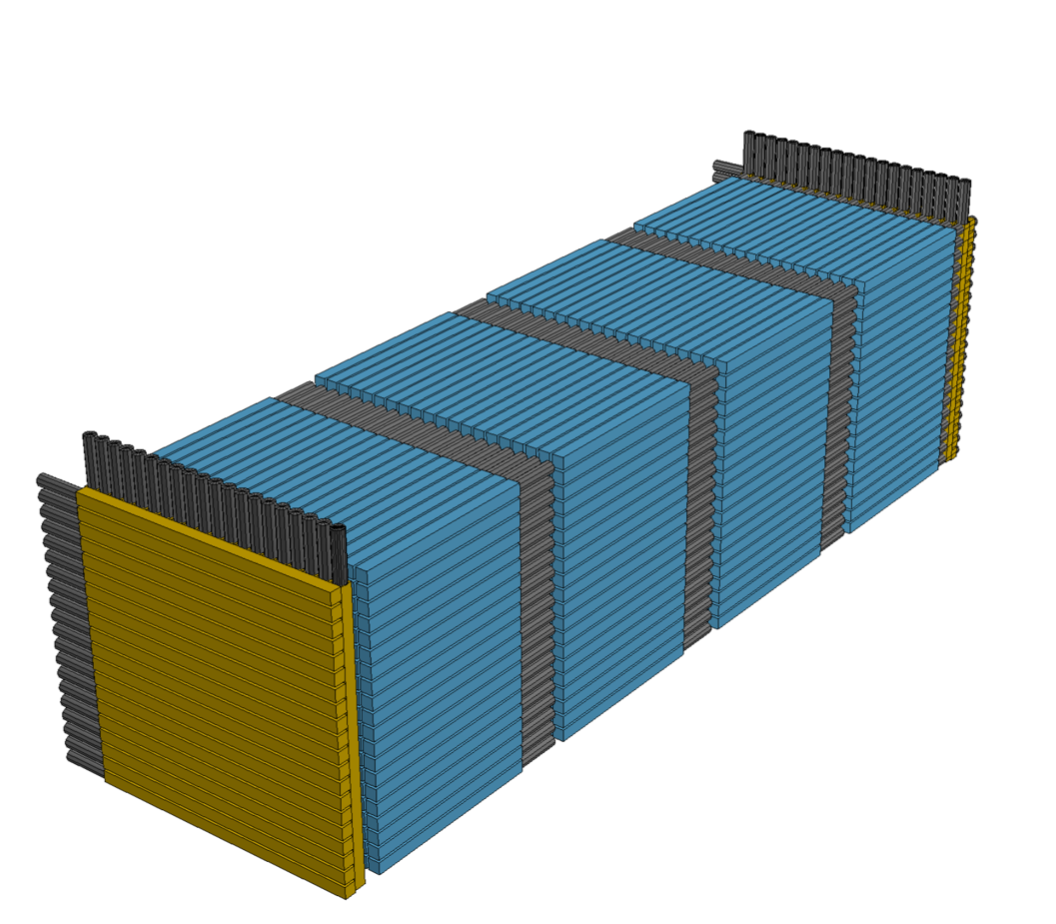The FPF provides an ideal location for a next-generation experiment to search for BSM particles that have an electrical charge that is a small fraction of that of the electron. Although the value of this fraction can vary over several orders of magnitude, we generically refer to these new states as “millicharged” particles (mCPs). Since these new fermions are typically not charged under QCD, and because their electromagnetic interactions are suppressed by a factor of (Q/e)2, they are “feebly” interacting and naturally arise in many BSM scenarios that invoke dark or otherwise hidden sectors. For the same reason, experimental observation of mCPs requires a dedicated detector.
FORMOSA will be a milliQan-type detector designed to search for mCPs at the FPF. FORMOSA will be technically similar to what the milliQan Collaboration has installed in the PX56 drainage gallery near the CMS IP at LHC Point 5 for Run 3, but with a significantly larger active area and a more optimal location with respect to the expected mCP flux.
To be sensitive to the small dE/dx of a particle with Q ≲ 0.1e, an mCP detector must contain a sufficient amount of sensitive material in the longitudinal direction pointing to the IP. The plastic scintillator is chosen as the detection medium with the best combination of photon yield per unit length, response time, and cost. Consequently, FORMOSA is planned to be a 1 m×1 m×5 m array of suitable plastic scintillator (e.g., Eljen EJ-200 or Saint-Gobain BC-408 ). The array will be oriented such that the long axis points at the ATLAS IP and will be located on the LOS. The array contains four longitudinal “layers” arranged to facilitate a 4-fold coincident signal for feebly-interacting particles originating from the ATLAS IP. Each layer in turn contains 400 5 cm × 5 cm × 100 cm scintillator “bars” in a 20 × 20 array. To maximize sensitivity to the smallest charges, each scintillator bar is coupled to a high-gain photomultiplier tube (PMT) capable of efficiently reconstructing the waveform produced by a single photoelectron (PE). To reduce random backgrounds, mCP signal candidates will be required to have a quadruple coincidence of hits with NPE ≥ 1 within a 20 ns time window. The PMTs must therefore measure the timing of the scintillator photon pulse with a resolution of ≤ 5 ns. The bars will be held in place by a steel frame.
Additional thin scintillator “panels” placed on each side of the detector will be used to actively veto cosmic muon shower and beam halo particles. Finally, the front and back of the detector will be comprised of segmented veto panels using perpendicular scintillator bars. This will provide efficient identification and tracking of the muons resulting from LHC proton collisions through the detector. During Run 2 of the LHC, a similar experimental apparatus (the milliQan “demonstrator”) was deployed in the PX56 draining gallery at LHC P5 near the CMS IP. This device was used successfully to search for mCPs, proving the feasibility of such a detector.
Even though the pointing, 4-layered design will be very effective at reducing background pro- cesses, small residual contributions from sources of background that mimic the signal-like quadru- ple coincidence signature are expected. These include overlapping dark rate pulses, cosmic muon shower particles, and beam muon afterpulses. Data from the milliQan prototype was used to predict backgrounds from dark rate pulses and cosmic muon shower particles for a closely related detector design and location. Based on these studies, such backgrounds are expected to be negligible for FORMOSA. Backgrounds from muon afterpulses can be rejected by vetoing a 10 μs time window in the detector following through-going beam muons. This veto will be improved by the muon tracking provided by the segmented bars at the front and back of the detector.
The FORMOSA detector is proposed to be constructed of plastic scintillator, however, in the coming years, the exciting possibility of using alternative scintillator material with significantly higher light-yield will be studied. One such material is CeBr3 scintillator (available from Berkeley Nucleonics). This provides a light yield approximately factor 30 times higher than the same length of plastic scintillator with excellent timing resolution. This would allow much lower charges to be probed with the FORMOSA detector. Further updates to the detector design can be studied with a FORMOSA demonstrator in the forward region of the LHC.
For more information, see the FORMOSA webpage.

